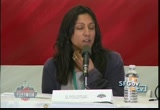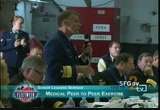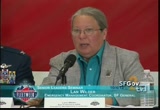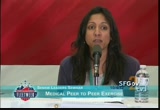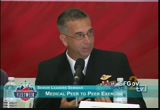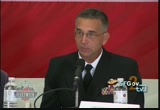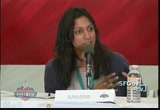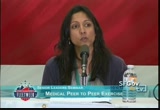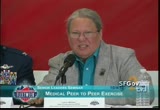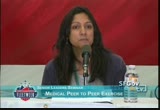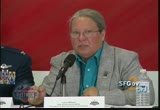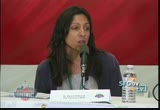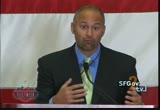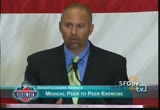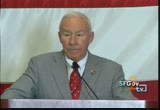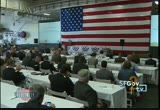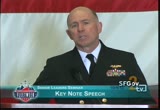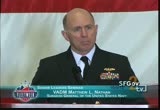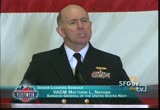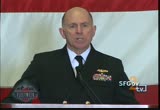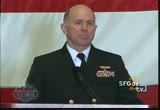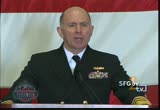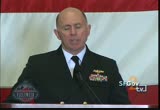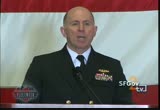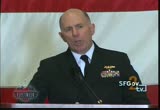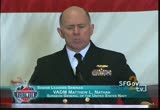tv [untitled] November 3, 2012 2:00am-2:30am PDT
2:00 am
manufacturers, if there were problems getting medications, that the federal government could facilitate that. but it is a great point. it's something locally we are working on with our pharmaceutical group because it is a big concern if we do lose supply how do we replenish that. san francisco does not have a lot of storage space so we are not able to store medications to a great extent in the area. >> i was just going to echo, our capability does come with its own internal pharmaceutical supply, although it is limited and so that would be important for us to understand what the resupply process would be as we move forward on that. so we can certainly hit the ground running, but then we would need some sort shortly thereafter. >> mine is a two-part question. we've seen in ismat turkey in 1999 a number of walking wounded that will immediately overwhelm the
2:01 am
medical response community and then how do you disallow them immediate health care and the specter of reality tv, so that would be the first part, managing expectation in our gold standard health care system. the other part of that response, to maximize the saving of lives, they actually severed limbs in the response process to maximize the safing lives. have we talked about indemnify case of our medical response teams post response? ?oo ?a we did not actually discuss indemnify case or any other legal or even ethical issues on a broader kail. all the hospitals do have plans to handle a surge of patients including a very large number of walking wounded. we assume they will arrive at the hospital starting immediately, even sometimes before the official announcement of a
2:02 am
particular incident unless it's an earthquake where we feel the announcement of the incident. but the real key is that those plans will need to be immediately operational so that we can sort out who really does need to come in and get what level of care and that varies by facility, depending on their capabilities, along with hospital lockdown plans to secure the overall physical plant and make sure those capabilities remain intact for all sorts of threats. and the other key piece is dph is an immediate back up to that with the ability to use our clinics and our other partners to stand up potentially alternate care centers and other types of, depeplding on the situation, other types of areas where people can be triaged or get information or get care if necessary. so those plans are in place, we're constantly developing
2:03 am
them because we have to really look and we don't have the ability to predesignate every site, after an earthquake we need to make sure each and every site we announce to the public is safe before it's announced so it's a complex type of situation with constant situational awareness that has to be included. >> i just wanted to add on to that, that dph has a great resource of clinics. we are working with our clinics to take on those potentially minor trauma victims that they can treat and offload the hospitals. it would be a matter of triaging them at the hospital level and get them over there. >> just one other key point on that. we would also be working very closely with our partners in dem and the communications sector to really get the word out through our non-emergency informationalized public messaging, whatever it takes to get the message out clearly,
2:04 am
even if it's spray painted signage on the signs of buildings, we will get the word out where it is appropriate to go. >> we do have a very defined triage process that we've used in our, on our navy and marine corps side we're quite used to. it would be important to try, that's maybe another training thing we want to work on, that we collaborate and understand we're using the same system because we don't want to create two systems of triage within the city. that's a good way to create more chaos than there might ordinarily be. >> i'd like to follow-up on one of the things that was mentioned about the walking wounded. one of the things that came up after yesterday's after action group was this concept of different patient groups. in the military you have a fairly healthy soldier that you are going to be providing aid to. in san francisco we have young, we have old that have much more complex issues that you may need to deal with. given your
2:05 am
capabilities, how would you address that? >> it's a significant concern although it may be a little bit artificial in that we do, our doctors and surgeons and nurses do take care of a wide number of population groups outside of active duty military either at their mtf's or in other previous medical care and disasters we have a experience with a wide range of third world countries and so on. we need to be sensitive on that but i don't believe there's a big training gap that exists in that setting. >> one of the other things that we're doing is also learning from our military partners. the event continues this afternoon with another part of the medical exchange where military subject matter experts are going to be presenting basically a grand rounds of what is new in trauma
2:06 am
care from battlefield experience and bringing that to the civilian medical personnel, which this alone is an extraordinary opportunity and what we can do to capitalize on so many of the innovations that have been made in medical care have come from the military and we need to take that and learn from it and see what we can do to improve care over all. >> other questions from our guests? >> i just had a question, as you are moving patients from -- they are entering the facility, they are entering the system and then they start getting handed out and eventually, i suppose, evacuated, did you guys talk about patient records and how you are tracking these patients? >> we did touch on it a bit during the exchange we had at noon. the national system is run through jtap which is a fantastic system and we've seen
2:07 am
it in a few of the exercises around. right now the region is doing a feasibility study if jtap would be feasible for us to use and if it is, it would be fantastic. our concern is if it's only used during a sdas ster and it's not used on a daily basis, are you going to have to spend a lot of time training? it's not really hard to use but there are some complexities with it. so it is a big job in the city tracking patient movement and we are addressing it. and i think we're waiting for the feasibility study to kind of determine what our next step would be. >> i think there was another question here. yes. >> yes, we know from hsda studies that for a very large earthquake you can expect perhaps tens of thousands of
2:08 am
individuals that will need hospital treatment and hospitals are generally fairly full anyway. was there any discussion of altered standards of care during your workshops? >> not during the workshop specifically but it is something we've discussed at our hospital council group on and off and it is something the counseling association of hospitals is working on as well. i think we have to think as a group locally what type of policy we would want to have. i don't know that we'd have an alternate standard but we might have a policy if there was a huge medical surge event what kind of standards we would be willing to accept and that would be working on in conjunction with all of our partners. >> that's probably one of the most difficult and controversial subjects in disaster medical response right now because it can be so difficultment until you are there in the situation and know
2:09 am
exactly what resources you have and what your capabilities are day by day it really will change so much. so that's why bringing in partners early to offload and shift where we can provide care will make a huge difference. we don't ever want to see providers making the kind of decisions that had to be made during katrina and other events. instead of having a set standard of care, even if it's an altered or austere standard of care, what we want to have is good decision framework. until you are in the situation you can't determine what you would actually be doing and what resources are still available. >> do we have other questions from our audience? one final question and this is for our civilians. you got to see all
2:10 am
kinds of cool stuff yesterday down at moffat's field. i want to see if there's one or two that stuck out. >> i think the c130 definitely blew me away, the fact it can transport 92 people, patients, was incredible. the other 1 that stands out is the mobile decon patient, that it can decontaminate a patient that was not able to stand. >> the team from the hospital that i was with and the other hospitals really looked at what were their hands on capabilities and some of the things that stood out the most is a portable oxygen generator that sits in the corner of the shock trauma platoon unit and doesn't have to be hooked up to our large liquid oxygen tanks and all that piping that might get disrupted during a major
2:11 am
seismic event. having something just that simple could make a huge difference. maybe we were thinking small but just really direct hablds on patient care, there was a portable iv pump and fluid warmer that literally would fit in your hand and is battery powered. anything that's portable and is battery powered will make a huge difference in the type of disasters we're facing. we can leave it with the patient, move it with the patient, i know they have a whole list of other things they want and we have to take a lack at that and see what we can actually do. >> i do have one question and it deals with licensing. we're going to have physicians performing medical operations and they aren't licensed in the state, does that present any kind of issue for the emergency response? >> so the state of california
2:12 am
has the disaster health volunteer system. and you can sign up on there and they will look at the credentials within 24 hours and say if -- that's the extent, though, they don't do any background checks. so the locals have to kind of develop their own policies and again that is something we're working on. we have a lot of great doctors and nurses in san francisco and knowing they would be willing to respond in case of a disaster is important. capturing that information on dhv and know they would be able to go to other facilities if need be is one of our big to do items. >> each hospital is also required to have a whole plan for credentialing volunteer medical professionals, both those who are licensed independent practitioners and those who have either certifications or other non-licensed kind of health
2:13 am
care practitioners and a whole way to integrate them into their response if necessary. it's part of the joint commission standards for hospitals in planning for emergency response as well. >> the military has no problem, then, your shock trauma platoon comes in and you have medical personnel, i guess i was aiming at the military side. if we have (inaudible) does that apply to the military. >> many of them who serve in california are not licensed in california, the military has a waiver for that requirement. so i'm not certain how that would apply if we're using those folks in a humanitarian disaster in california. we're able to treat our folks regardless of the state of licensing in a particular
2:14 am
state, though. >> last year when i took a look at the shock trauma platoon, and i'm going to talk to you about that one really cool thing i saw. i have a little bit of medical experience and to see they have effectively a robotic soldier that can go into defib, whose eyes can dilate, they can do pulses both radial and distal and there is a programmer who is effectively testing a battlefield soldier what to do, i found absolutely fascinating as a way to bring a real life experience to that individual. for me that was a fantastic tool that you have and i thought that was wonderful. >> we're going to be -- little advertisement -- we're going to be demonstrating that capability at our display at the marina green so if you'd like to come see that, that's available. >> any final questions? i'd like to thank our panelists
2:15 am
very much. as rob mentioned earlier, the exercise series we have put on and started 3 years ago has really become, for the department of emergency management and we hope for the military, this foundational piece of the fleet week humanitarian exchange. it's been a wonderful way for us to work together on some of these common issues and figure out how our agencies are all going to integrate. i think the time and effort that has been expended by both the military planners and also the civilian planners is definitely going to be bearing fruit in years to come when something happens. i know we are quite a bit ahead of time, you are going to have a 20-minute break from now and then our next speaker will come up at that point. thank you again.
2:17 am
2:18 am
awards and his most recent command was as the commander of walter reed, and i was so glad that he was here to hear the panel that we had with our medical peer to peer exercise. and he's going to talk to us now about navy medicine. with that, please help me welcome vice admiral matthew nathan. (applause). >> thank you, general, very much. well, it's a pleasure here and i'm honored to be able to speak in front of such a distinguished audience. secretary schultz, mrs. schultz, pleasure it see you and you lend tremendous gaffe tas to this program. general spees, distinguished flag officers, general officers and mostly everybody here who is in
2:19 am
the readiness business, i am honored to be speaking to a group of people and that would include i think everybody in this hanger deck who is part of that cadre of individuals who when bad things happen and everybody runs out, your job is to run in. it doesn't get better than this coming out here. the a's are in, the giants are in. back in dc's the national's had the best -- who would have thunk it. and being on this ship, skipper pringle, congratulations on a great ship and a superb crew. as you get higher up in the navy you get less and less opportunity to be on a ship as i head back to the bureaucracy, my only request to you is for god's sake take
2:20 am
me with you. i'll work in the engine room, i'll chip paint, i'll do anything to be hayes-white gray and underway. i'm responsible to them primarily for our wartime mission. my job is the readiness mission, as is yours. i have to be ready for the next big thing whatever it is. it may be somebody that's blown up, it may be a unit taking fire, it may be a mass casualty, it may be mass relief or to those of our neighbors and allies, it may be somebody getting ready to deliver a baby. imagine we are sitting in this
2:21 am
venue oopbd all of a sudden your pager goes off, your associate comes up and taps you on the shoulder and says, you need to see this. there has been a bomb that's gone off in our nation's capital or los angeles, a nuclear device. there has been an earthquake. there has been a hurricane where we thought the good news was the winds blew and it did some damage but all is well, oh, my god, the levies just broke. oh, by the way, there's an earthquake or a tsunami or a nuclear critical accident that's occurred somewhere overseas. how will we respond to that? and then let's bring it closer to home, how did we marry up the capabilities that exist because there is no greater tragedy than to have robust capabilities, mellow
2:22 am
medical, logistical or otherwise. you are better prepared with every one of these meetings, you are better prepared with every networking that happens in the hallways and exchanging business cards but you will never be absolutely prepared. what we're doing here today and in future events is a journey, it is not a destination. we will never be able it high five ourselves and say we have everything figured out and we'll be able to solve it the minute it happens. ask anyone who has been in the throes of a complex medical emergency. i congratulate you on leaning forward and recognizing the next nightmare scenario may be around the corner and our job, the american people have come to rely on us to be able to stand between them and trouble, to be able to jump out in front of them and say, get behind me, i will lead you through this, i will get us out of this. i will build the relationship, i will build the networks, i will
2:23 am
build the competence and professionalism that will change lives and save lives and make a difference. i will learn from the lessons of the past as difficult and as gruesome as some of them are. i will learn from the lessons that have occurred on our shores and on other shores. as i said, i'm in the readiness business. here's some of the capability we bring to the plate. if i were to tell you that if you were walking out somewhere and you were to step on a bomb, an improvised explosive device, and its detonation capacity was such it would take off all four of your limbs and cave in your skull, what are the opportunities you would survive that? today that happens. my prior job, as was mentioned, is to be the commander of the national naval medical center and oversee the integration of that with walter reed army medical center to what's now known as
2:24 am
the walter reed national medical center at bethesda. pretty challenging the cultures that exist there, you have cultures that exist here, you are speaking about cultural differences between the military and its hierarchy of command and control and the civilian command and control and figuring out the two greatest things you need in the chaos of disaster. no. 1, communications. no. 2, who's in charge. i dealt with a lot of cultural issues when i was combining the army and the navy medical forces between walter reed and bethesda. america's army is an amazingly heroic army. they have occupied valley forge , tokyo, berlin, danang and now it occupies bethesda, maryland, but we're working through that. how do we break those cultural
2:25 am
barriers, how do we figure out supporting supporters, how do we do that before the next capacity goes on? so what have we done, what capabilities do we bring, where do we use them and how will they be playing a role here in the event of the most likely nightmare scenarios for this area? i grew up in the bay area, i have tremendous affection for it. i did train on the east coast but i grew up in santa clara and in napa, i used to come down and watch candlestick park, my dad would bring me down, i would watch the 49ers play and i have great pride in the amount of collaboration and cooperation you are showing to figure out what the next nightmare scenario might be and be ready for it. it's probably going to be either an earthquake, it may be a man-made catastrophe such as an heinous terrorist act that
2:26 am
could range anywhere from a mass casualty with chem-bio, be it small pox, be it chemical gasses, be it tactical nuclear effect, to a pandemic. avian influenza. how prepared will we be? let's get back to that marine or sailor that's blown up? in previous conflicts from the time you were grievously injured to the time you were eventually immediate vaked back to the states to a tertiary care facility such as a tertiary care medical facility such as walter re d
2:27 am
or bethesda or san diego or brooke army in texas or a va medical center, that time of injury to time of immediate vak was 45 to 60 days. ladies and gentlemen, today if you are a warrior and you are blown up or griefously injured, on average from the time you are grievously injured to the time you arrive in my icu in bethesda is 3 days. that capability is provided to us by on screen care with unparalleled first responder action that can save the live, tourniquet therapy, clotting agents, understanding, robust immediatevac capibility, and then a continuing continuum to germany and back to the states in the c130's, the flying icu's which the air force has, which you are safer in the air at
2:28 am
30,000 feet than you are in 90 percent of the icu's in this country. they do not lose patients over the atlantic. they do not lose patients over the pacific and, remember, they transport them within days, days, of them being critically injured. the patient will wake up for the first time in a hospital in the states. that is often the first time they wake up. that's how fast the medevac system goes. wouldn't it be a shame to waste that compartment of skills on a mass casualty event that occurs here. well, we have hospitals and they're going to be okay and we have a robust provider system, and you do, one that the cities and counties and states should be proud of. because they get it. they get it out here. but the hospitals, they will have to figure it out. but what if you are a country and all of a sudden you have an
2:29 am
earthquake and by the way the one thing you need most because of that earthquake, the hospital infrastructure, is gone. can we describe a scenario that could be like that? i remember when i was in college a popular thing was the national lampoon and they did a parody of the political science final. please write a scenario where world events and powers provide and results in total thermonuclear warfare results and the next question was, please create a lab practical to test your theory. is there a lab practical to test this theory? haiti. as you know, a few years ago the haitian people suffered an
116 Views
IN COLLECTIONS
SFGTV2: San Francisco Government Television Television Archive
Television Archive  Television Archive News Search Service
Television Archive News Search Service 
Uploaded by TV Archive on

 Live Music Archive
Live Music Archive Librivox Free Audio
Librivox Free Audio Metropolitan Museum
Metropolitan Museum Cleveland Museum of Art
Cleveland Museum of Art Internet Arcade
Internet Arcade Console Living Room
Console Living Room Books to Borrow
Books to Borrow Open Library
Open Library TV News
TV News Understanding 9/11
Understanding 9/11